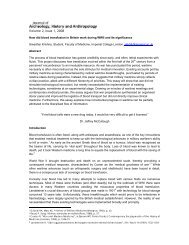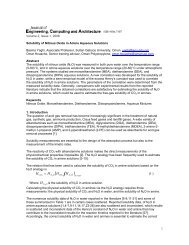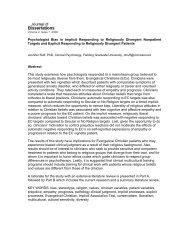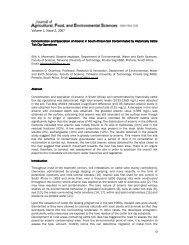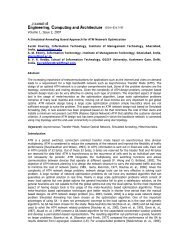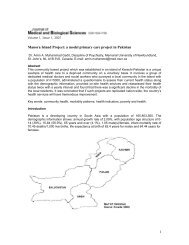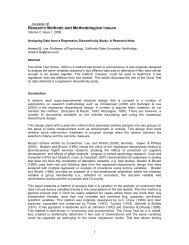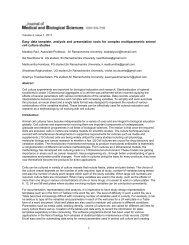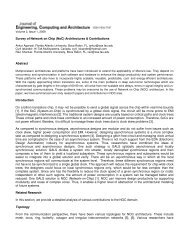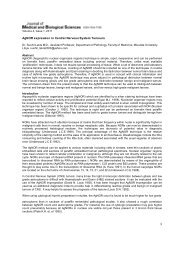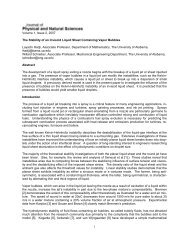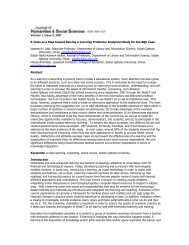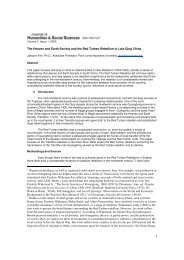School Shootings: The Deadly Result of Teasing and Ostracism?
School Shootings: The Deadly Result of Teasing and Ostracism?
School Shootings: The Deadly Result of Teasing and Ostracism?
Create successful ePaper yourself
Turn your PDF publications into a flip-book with our unique Google optimized e-Paper software.
Volume 2, Issue 1, 2010<br />
<strong>School</strong> <strong>Shootings</strong>: <strong>The</strong> <strong>Deadly</strong> <strong>Result</strong> <strong>of</strong> <strong>Teasing</strong> <strong>and</strong> <strong>Ostracism</strong>?<br />
Georgie Ann Weatherby, Ph.D., Associate Pr<strong>of</strong>essor <strong>of</strong> Sociology <strong>and</strong> Criminal Justice, Gonzaga University, weatherb@gonzaga.edu<br />
Sara Strachila, Gonzaga University, sstrachi@gonzaga.edu<br />
Bridget McMahon, Gonzaga University, bmcmahon@gonzaga.edu<br />
Abstract<br />
Leary, Kowalski, Smith, & Phillips (2003) conducted a comprehensive analysis <strong>of</strong> school shootings in the United<br />
States from their recorded beginnings in 1995 to 2001. Findings involved bullying, isolation, <strong>and</strong> a strong need to<br />
“strike back.” Suicide by cop – a term used to describe a way to end one’s life in glory by being taken down in a gunbattle<br />
with police, was identified as a common goal with infamy <strong>of</strong>ten the intended outcome. Present results reported<br />
here (2001-2008) reflect a mixture <strong>of</strong> these variables throughout, but no clear pattern emerges. <strong>The</strong> impetus for<br />
shootings ranges from spurned romantic relationships to bullying to paranoia. Various theories <strong>of</strong> differential<br />
association, social control, <strong>and</strong> anomie are applied to explain the diverse motives.<br />
Keywords: school shootings; ostracism; teasing; bullying; differential association theory; social control theory;<br />
anomie theory<br />
Introduction<br />
In recent years there has been increasing interest in juvenile criminals, specifically those who kill. Outrage is added<br />
when the tragic event happens at a school. This tumult has led many people to believe that homicides committed by<br />
juveniles at school are on the rise. However, according to National <strong>School</strong> Safety <strong>and</strong> Security Services, there has<br />
been a general decline <strong>of</strong> school-associated violent deaths from 1999 to the present, with the exception <strong>of</strong> an<br />
increase from 2003-2004 (National <strong>School</strong> Safety <strong>and</strong> Security Services, 2009). Although the trend is on a decline, it<br />
is important to underst<strong>and</strong> what it is that leads juveniles to commit such violent acts. in order to increase awareness<br />
<strong>and</strong> prevention to communities, schools, <strong>and</strong> families <strong>of</strong> those who would be potentially at-risk.<br />
This paper will focus on three criminological theories—differential association, social control, <strong>and</strong> anomie, <strong>and</strong> how<br />
they help us to underst<strong>and</strong> the mentality <strong>of</strong> juveniles who commit these acts <strong>of</strong> school violence. Differential<br />
association theory, developed by Edwin Sutherl<strong>and</strong>, states that criminal behavior is learned in social environments<br />
(Sutherl<strong>and</strong>, 1939). This means that juveniles will be influenced by those with whom they interact. Based upon this<br />
theory, delinquency, including the violence necessary for school shootings, can be learned.<br />
When defining social control theory, sociological variables such as peer groups, family structures, <strong>and</strong> schooling have<br />
been recognized as major causes <strong>of</strong> crime <strong>and</strong> delinquency. Travis Hirschi’s description states that deviant behavior<br />
is deterred by a variety <strong>of</strong> communal restraints (Hirschi, 1969). Physical abuse, sexual abuse, instability <strong>of</strong> caretaker<br />
situation <strong>and</strong>/or residency, absence <strong>of</strong> a father, parental alcohol or drug abuse, parental psychiatric history, parental<br />
criminal background, <strong>and</strong> violence in the home are eight prominent familial factors that researchers have attributed to<br />
the pr<strong>of</strong>ile <strong>of</strong> juvenile killers (Heckle & Shumaker, 2001). Hirschi (1969) would propose one reason the students<br />
committed these shootings was because they had an unstable family relationship, leading to abnormal societal<br />
bonds.<br />
Anomie theory, introduced by Emile Durkheim, states, “…the general procedural rules <strong>of</strong> a society (the rules that say<br />
how people ought to behave toward each other) have broken down <strong>and</strong> people do not know what to expect from each<br />
other” (Durkheim, 1893; Williams & McShane, 2004: 96). Durkheim would suggest that these juveniles who commit<br />
school shootings feel a sense <strong>of</strong> normlessness in their society, <strong>and</strong>, therefore, act out in violence.<br />
In this paper, we seek to establish what factors contribute to the mentality <strong>of</strong> juveniles who engage in criminal<br />
behavior through school shootings. To do so this study will be a continuation <strong>of</strong> previous research conducted on<br />
school shootings by Leary, Kowalski, Smith, & Phillips published in (2003). <strong>The</strong> original study focused on several<br />
factors, the prominent ones being rejection <strong>and</strong> ostracism. It concluded on March 7, 2001, <strong>and</strong> the current study will<br />
1
analyze school shootings from that point forward. <strong>The</strong> answer to this research question will then be used to determine<br />
the societal implications <strong>of</strong> the factors influencing school shooters.<br />
Literature Review<br />
Much research has been done regarding what influences juveniles to commit violence acts in schools; however, there<br />
has also been much disagreement. Previous research has suggested that different factors influence different types <strong>of</strong><br />
violence within schools. Some have blamed violence on the macro structure <strong>of</strong> the school, while others have placed<br />
blame on the more micro-level environment within the school. <strong>The</strong> focus <strong>of</strong> this research is to determine whether<br />
rejection <strong>and</strong> ostracism influence youths to commit homicide in schools.<br />
Homicides can be divided into categories specifying the type <strong>of</strong> killing committed. One type, senseless homicides,<br />
can then be subcategorized into six groups—“thrill” killings, “hate” killings, “romantic” murder-suicides, “revenge”<br />
killings, “cult-related” killings, <strong>and</strong> killings that are carried out by mentally disturbed individuals (Ewing, 1990).<br />
Senseless killings are “committed by relatively normal juveniles acting on impulse—<strong>of</strong>ten in conjunction with or under<br />
the influence <strong>of</strong> other juveniles” (Ewing, 1990, p 63). Most school shootings would be classified as a senseless killing<br />
under the subcategory <strong>of</strong> revenge since the juvenile shooters tend to seek retribution from those who have wronged<br />
them at school.<br />
Newman, Fox, Harding, Mehta, & Roth (2004) studied several theories <strong>and</strong> explanations behind school shootings. In<br />
the book Rampage: <strong>The</strong> Social Roots <strong>of</strong> <strong>School</strong> <strong>Shootings</strong>, Newman et al. explored ten different theories. <strong>The</strong>y<br />
included mental illness, what they called “he just snapped,” family problems, bullying, peer support, changing<br />
communities, culture <strong>of</strong> violence, gun availability, violent media, <strong>and</strong> the copycat effect. Newman et al. do not specify<br />
which factors have the biggest effect on shootings in schools, but they do discredit the “he just snapped” theory, due,<br />
at least in part, to the premeditation involved.<br />
<strong>School</strong> violence in general has also been attributed to the location <strong>of</strong> the school <strong>and</strong> <strong>of</strong> the residence <strong>of</strong> the student<br />
(Kramer, 2000). Kramer argues that “broader social <strong>and</strong> economic forces such as poverty, inequality, <strong>and</strong> social<br />
exclusion shape most <strong>of</strong> the problem <strong>of</strong> youth violence in America” (p. 123). He contends that poverty takes parents<br />
<strong>and</strong> guardians out <strong>of</strong> the homes for longer periods <strong>of</strong> time than parents in other socioeconomic strata <strong>and</strong> these<br />
absences allow children to go astray.<br />
Other authorities on the topic <strong>of</strong> school violence place the blame on the structure <strong>and</strong> organization <strong>of</strong> the school itself.<br />
This theory <strong>of</strong> organizational deviance states that it is the different actors in the school system not connecting with<br />
one another <strong>and</strong> creating chains <strong>of</strong> information that only lead to dead ends which leads to warning signs <strong>of</strong> violence<br />
going unnoticed. Fox <strong>and</strong> Harding (2005) studied the roles schools played in the shootings in West Paducah,<br />
Kentucky, <strong>and</strong> Jonesboro, Arkansas, <strong>and</strong> the lack <strong>of</strong> prevention <strong>of</strong> the incidents. <strong>The</strong>y found “with few exceptions,<br />
school <strong>of</strong>ficials were unaware that the shooters in these incidents were experiencing severe emotional, social, <strong>and</strong>/or<br />
behavioral problems or that they had such rage against the institution” (Fox & Harding, 2005, p.69). This is<br />
organizational deviance, defined as “when events that are created by or in organizations do not conform to an<br />
organization’s goals or expectations <strong>and</strong> produce unanticipated <strong>and</strong> harmful outcomes” (Fox & Harding, p. 70). <strong>The</strong>y<br />
also argue that “because the problems <strong>of</strong> individual students <strong>of</strong>ten do not interrupt the basic functioning <strong>of</strong> the school,<br />
they can fester unnoticed until a larger problem, such as a school shooting, occurs” (Fox & Harding, p. 73). One <strong>of</strong><br />
their conclusions is that most students who become school shooters do not attract any attention. <strong>The</strong>y fly under the<br />
radar <strong>of</strong> the school administration, which focuses attention on the children who create problems.<br />
Another factor that some believe helps contribute to school shootings is that schools are not taking sufficient<br />
measures in order to prevent these types <strong>of</strong> disasters. Easterbrook (2002) argued that some <strong>of</strong> the preventive<br />
measures that schools have taken lead to poor outcomes. Easterbrook used violent language as an example <strong>of</strong> this ill<br />
effect. It <strong>of</strong>ten occurs that youths who are caught using violent language on school grounds are punished “without<br />
considering the context <strong>of</strong> those statements or the behavioral history <strong>of</strong> the students” (Easterbook, p. 56). Instead <strong>of</strong><br />
an overreaction to violent language <strong>and</strong> an increase in heightened security, Easterbrook asserted schools with a<br />
“nurturing environment <strong>and</strong> increased access to counseling” would be a better benefit in prevention than turning<br />
schools into a prison.<br />
Dewey G. Cornell <strong>of</strong> University <strong>of</strong> Virginia’s Curry <strong>School</strong> <strong>of</strong> Education addressed the House Judiciary Committee at<br />
the Oversight Hearing to Examine Youth Culture <strong>and</strong> Violence in May 1999. He believed that violent youth fall into<br />
three categories. <strong>The</strong> first category is the mentally ill who “suffer from delusions that guide behavior” (Cornell,<br />
1999).<strong>The</strong> second category, which contains two-thirds <strong>of</strong> all violent youth, are the antisocial youth who have “a long<br />
history <strong>of</strong> delinquent <strong>of</strong> (sic) disruptive problems evident in early childhood” (Cornell). <strong>The</strong> third category has no<br />
name. <strong>The</strong>se are the “normal youngsters whose acts <strong>of</strong> violence surprise us” (Cornell). <strong>The</strong>y are “highly sensitive to<br />
2
teasing <strong>and</strong> bullying, are deeply resentful, ruminating over perceived injustices” (Cornell). Cornell also noted that the<br />
shooters up to the time <strong>of</strong> the delivery <strong>of</strong> his speech were the victims <strong>of</strong> bullying <strong>and</strong> teasing.<br />
McCabe <strong>and</strong> Martin (2005) investigated school violence, the effect the media plays in the dissemination <strong>of</strong> crime<br />
information, <strong>and</strong> what has been done in response to school shootings. According to McCabe <strong>and</strong> Martin, bullying has<br />
four initial elements: an imbalance <strong>of</strong> power, intent to harm, a threat <strong>of</strong> further aggression, <strong>and</strong> terror. <strong>The</strong>y also argue<br />
that bullies have a need for power <strong>and</strong> control <strong>and</strong> “tend to come from families where physical punishment is the<br />
norm <strong>and</strong> bonding among parents <strong>and</strong> children is limited” (McCabe & Martin, p. 27). In their research, they also<br />
discovered six common traits <strong>of</strong> bullies. <strong>The</strong>se traits are: a desire for domination, manipulation <strong>of</strong> others to obtain a<br />
goal, egocentrism <strong>of</strong> the bully, the view that the prey are weaker, the failure to accept responsibility for their actions,<br />
<strong>and</strong> the seeking <strong>of</strong> attention (McCabe <strong>and</strong> Martin). <strong>The</strong> victims <strong>of</strong> the bullies are <strong>of</strong>ten insecure, have low-self esteem,<br />
are unwilling to protect themselves, <strong>and</strong> are only attractive to bullies as long as they do not fight back. In addition, this<br />
type <strong>of</strong> subjugation bonds victims together. Those who are bullied may associate with other victims <strong>and</strong> may<br />
participate in antisocial activities, such as school shootings (McCabe & Martin, 2005). But, as McCabe <strong>and</strong> Martin<br />
point out, no one can be sure that bullying directly influences these incidents.<br />
Along similar lines, the United States Secret Service conducted an investigation in conjunction with the U.S.<br />
Department <strong>of</strong> Education on violence in schools in an attempt to develop a pr<strong>of</strong>ile <strong>of</strong> a school shooter <strong>and</strong> to provide<br />
a threat assessment. <strong>The</strong>ir preliminary findings are important. Published in October 2000 <strong>and</strong> studying school<br />
shootings up to that point from the 1990s, the <strong>School</strong> Safe Initiative found that in almost all studied incidents “the<br />
attacker developed the idea to harm the target before the attack” <strong>and</strong> “in well over ¾ <strong>of</strong> the incidents, the attacker<br />
planned the attack” (United States Secret Service, 2000, p.3). <strong>The</strong>y also discovered that “more than half <strong>of</strong> the<br />
attackers had revenge as a motive” (p. 3). In addition, “More than 3/4 <strong>of</strong> the attackers were known to hold a grievance<br />
at the time <strong>of</strong> the attack” (p. 3). <strong>The</strong>y were also able to identify bullying as a major influence in school shootings. <strong>The</strong>y<br />
discovered “In over 2/3 <strong>of</strong> the cases, the attackers felt persecuted, bullied, threatened, attacked or injured by others<br />
prior to the incident” <strong>and</strong> “a number <strong>of</strong> attackers had experienced bullying <strong>and</strong> harassment that was longst<strong>and</strong>ing <strong>and</strong><br />
severe” (United States Secret Service, p 7). Yet the Secret Service determined that there was no accurate pr<strong>of</strong>ile <strong>of</strong><br />
a school shooter.<br />
One <strong>of</strong> the key pieces <strong>of</strong> literature in the area <strong>of</strong> school shootings, however, is that <strong>of</strong> Leary et al. <strong>The</strong>ir case study <strong>of</strong><br />
fifteen schools was able to identify three forms <strong>of</strong> rejection <strong>and</strong> three other risk factors that were present in school<br />
shootings occurring from 1995 to 2001 (Leary et al., 2003). In their background research, Leary, et al. found that the<br />
perpetrators <strong>of</strong> school shootings were seen as outcasts within their schools <strong>and</strong> that as rejection increased, so did the<br />
danger <strong>of</strong> aggressive behavior. <strong>The</strong> rejection that the perpetrators suffered gave them the impression that they were<br />
not accepted or valued. To exacerbate these feelings <strong>of</strong> rejection <strong>and</strong> hurt, most <strong>of</strong> the bullying <strong>and</strong> ostracism<br />
occurred in public <strong>and</strong> in front <strong>of</strong> other people (Leary et al., 2003). <strong>The</strong> results <strong>of</strong> the Leary et al.study found that “in at<br />
least 12 <strong>of</strong> the 15 incidents, the perpetrator(s) had been subject to a pattern <strong>of</strong> malicious teasing or bullying” (2003:<br />
210). Furthermore, “at least 10 <strong>of</strong> the 15 incidents involved a perpetrator who had shown previous evidence <strong>of</strong> having<br />
psychological problems” (Leary et al., p. 210). <strong>The</strong> researchers were adamant in noting that “few <strong>of</strong> the perpetrators<br />
attributed their violent behavior to other equally plausible causes, such as disinterested parents, a broken home, child<br />
abuse, academic failure or psychological problems” (Leary et al., p. 211). <strong>The</strong>y saw their transgressions as stemming<br />
from their victimizations. In addition, this study provided a fit model for a case study that could be used in future<br />
research <strong>of</strong> other school shootings.<br />
Gillespie (2002) believes bullying at school plays a significant role in the events leading up to a school shooting as<br />
well. He used the 1999 Columbine shooting as an example <strong>and</strong> detailed the humiliating torment that Dylan Klebold<br />
<strong>and</strong> Eric Harris faced from peers while attending school. After the deadly school shooting, Newsweek printed a quote<br />
from a classmate saying Klebold <strong>and</strong> Harris walked the halls “with their heads down, because if they looked up they’d<br />
get thrown into lockers <strong>and</strong> get called a ‘fag’” (as cited in Gillespie, 2002, p. 11). Gillespie has also examined popular<br />
films. When comparing movies such as <strong>The</strong> Outsiders, Carrie, <strong>and</strong> Buffy the Vampire Slayer—all <strong>of</strong> which expose<br />
school culture as loutish <strong>and</strong> disturbing —Gillespie states “…we cannot even imagine schools that are not just a few<br />
steps removed from Lord <strong>of</strong> the Flies” (2002, p. 12). Bullying is an antagonizing factor in school shootings.<br />
Larkin’s (2007) work also focuses on bullying in Columbine High <strong>School</strong> both before <strong>and</strong> after the shooting. He<br />
interviewed teachers, students, <strong>and</strong> community members about the school environment prior to the shooting, the<br />
incident itself, <strong>and</strong> the atmosphere <strong>of</strong> the school several years later. Through this, he was able to determine that the<br />
school system, meaning the teachers <strong>and</strong> the administration, allowed bullying to happen within the school. Larkin<br />
also notes through interviews with students that the bullying was especially rampant before the time <strong>of</strong> the attack <strong>and</strong><br />
because <strong>of</strong> this many students were carrying guns <strong>and</strong> knives for protection.<br />
In addition, many people believe school shootings occur when students unpredictably snap because they are bullied<br />
to the point where they feel they need to seek justice on their own behalf. However, in Joseph Lieberman’s (2006)<br />
3
<strong>The</strong> Shooting Game: <strong>The</strong> Making <strong>of</strong> <strong>School</strong> Shooters, he studied school shootings that had taken place over a span<br />
<strong>of</strong> 30 years <strong>and</strong> came to the realization that many, if not all, shootings were premeditated. As Lieberman describes it:<br />
All <strong>of</strong> them required some degree <strong>of</strong> planning, <strong>and</strong> several, such as Columbine <strong>and</strong> De Anza Community<br />
College, were laid out in detail far in advance. <strong>The</strong> more accomplices are involved, the more plotting was<br />
required. Among loners, the plan <strong>of</strong> attack may have been less well thought out, but all <strong>of</strong> them required at<br />
least the procurement <strong>of</strong> weapons, a means <strong>of</strong> transportation, <strong>and</strong> a consideration <strong>of</strong> the layout <strong>of</strong> the<br />
school, location <strong>of</strong> students <strong>and</strong> timing (2006, p. 1).<br />
Here, this 30 year study took out <strong>of</strong> consideration the impulsivity <strong>of</strong> the shooters as a possible factor behind the<br />
shootings.<br />
<strong>The</strong> most important complement to Lieberman <strong>of</strong> all, however, were the eight warning signs <strong>of</strong> violence discovered by<br />
McCabe <strong>and</strong> Martin in a slightly earlier study (published in 2005). Those signs include:<br />
1. History <strong>of</strong> poor academic achievement.<br />
2. Disciplinary problems at school (usually because they do not feel close to the school environment).<br />
3. Difficulties with social skills <strong>and</strong> peers.<br />
4. History <strong>of</strong> violence toward peers.<br />
5. Views <strong>of</strong> aggressive behavior as normal <strong>and</strong> acceptable.<br />
6. Involvement with alcohol <strong>and</strong>/or drugs.<br />
7. Access to firearms.<br />
8. History <strong>of</strong> family problems, such as rejection, violence, <strong>and</strong> a lack <strong>of</strong> supervision. (McCabe <strong>and</strong> Martin,<br />
2005: 82-83).<br />
<strong>The</strong>se do not all need to be present at once, but one or any combination <strong>of</strong> them could prove to be fatal.<br />
Much research has focused on the real threat <strong>of</strong> school violence as opposed to the threat that the general public<br />
believes based on the media. <strong>The</strong> Justice Policy Institute funded a study called <strong>School</strong> House Hype, published in<br />
1998, by Donahue, Vincent, & Ziedenberg, that examined the real threat posed to students in schools. It found that<br />
there is a one in one million chance <strong>of</strong> a student being killed in school <strong>and</strong> that fewer homicides were committed by<br />
juveniles at the time <strong>of</strong> publication than in 1965 (Donohue, et al., 1998). Yet the public does not know this because,<br />
as the Justice Policy Institute put it, “Rather than providing context, the media’s linking <strong>of</strong> these shootings as a ‘trend’<br />
has tended to exacerbate people’s fears about the safety <strong>of</strong> their children <strong>and</strong> youth in school. <strong>The</strong> result is that<br />
misdirected public policy is being generated to safeguard the schools, even though the real threat may lie elsewhere”<br />
(Donohue, et al., 1998, pp. 4-5). Donohue et al. also discovered that the attention the media had placed on the school<br />
shootings was leaving impressions on the public that were not congruent with the reality <strong>of</strong> school shootings. <strong>The</strong><br />
study found that violence in school was more likely to happen in an urban setting, rather than in rural areas as<br />
incidents recently in the news had been depicted. Also, the threat <strong>of</strong> violence against students was down. Students<br />
were more likely to report being threatened or injured by a weapon at school in 1976 than in 1996 (Donohue, et al.).<br />
Sociological <strong>The</strong>ories<br />
Social Control<br />
Social control theory states that school shootings occur when the perpetrator’s bonds to society weaken, also known<br />
as a decrease in social capital. Kramer (2000) defines social control as involving “all the sanctions <strong>and</strong> constraints<br />
used in an effort to control another individual’s behavior (to make him or her conform to social norms)” (p. 126).<br />
Kramer argues that poverty takes parents away from the home, reducing social control. He also says that poverty<br />
reduces social supports for children, leading them to feel excluded. When a parent is away from the home, he or she<br />
has less time to spend with the child creating bonds. Kramer cites a government study that found “youth crime is<br />
related inversely to ‘child-parent involvement, such as the amount <strong>of</strong> intimate communication, confiding, sharing <strong>of</strong><br />
activities, <strong>and</strong> seeking help’” (Kramer, 2000: 127). <strong>The</strong>se are all ways that would increase the strength <strong>of</strong> social<br />
control, meaning that when they are absent, the child’s bonds to society are weakened.<br />
Welsh (2000) enhances the argument that delinquency is the result <strong>of</strong> weak social bonds. He states, “Control<br />
theorists contend that delinquency is the result <strong>of</strong> a weakening <strong>of</strong> effective social <strong>and</strong> cultural constraints, especially<br />
via weakened transmission <strong>of</strong> values through institutions such as the family <strong>and</strong> the school” (p. 91). In his research,<br />
Welsh examined five scales that coincide with Hirschi’s control theory. He examined school involvement, positive<br />
peer associations, belief in school rules, school effort, <strong>and</strong> school rewards. He found that “those who believed in<br />
school rules, reported great school effort, <strong>and</strong> associated with nondeviant peers all evidenced much less <strong>of</strong>fending”<br />
(Welsh, p. 98). He also found that not believing in the rules <strong>of</strong> the school was a strong predictor <strong>of</strong> misconduct..<br />
4
McCabe <strong>and</strong> Martin (2005) also believe that the social control is applicable to school violence. <strong>The</strong> four elements <strong>of</strong><br />
social control (attachment, commitment, involvement, <strong>and</strong> belief) all play a part. <strong>The</strong> attachment element regards<br />
peers <strong>and</strong> family. <strong>The</strong> commitment is to society, <strong>and</strong> is shown by following the rules. Involvement is an opportunity to<br />
create a social bond. This means that if one is involved in a socially acceptable activity, there is little or no time for<br />
delinquency. And finally, belief regards the rules <strong>of</strong> the school. If a student does not believe in the rules, he or she is<br />
more likely to break them <strong>and</strong> become delinquent.<br />
Newman et al. (2004) found “five necessary but not sufficient conditions” based on the shootings in West Paducah<br />
<strong>and</strong> Jonesboro to explain why school shootings occur. Newman et al.state:<br />
<strong>The</strong> first necessary factor is the shooter’s perception <strong>of</strong> himself as extremely marginal in the social worlds<br />
that matter to him. Second, school shooters must suffer from psychosocial problems that magnify the impact<br />
<strong>of</strong> marginality. Also ‘cultural scripts’— prescriptions for behavior — must be available to lead the way toward<br />
an armed attack. <strong>The</strong> fourth necessary factor is a failure <strong>of</strong> surveillance systems that are intended to identify<br />
troubled teens before their problems become extreme. Finally, we come to gun availability (Newman et al.<br />
2004, pp. 229-230).<br />
All five factors clearly show a weakened bond between the individual <strong>and</strong> society, thus emphasizing social control as<br />
a prominent theory contributing to school shootings.<br />
Anomie <strong>The</strong>ory<br />
Anomie theory explains that school shootings come about as the result <strong>of</strong> a state <strong>of</strong> confusion or normlessness.<br />
When Kramer (2000) speaks <strong>of</strong> anomie theory he builds on the work <strong>of</strong> Messner <strong>and</strong> Rosenfeld who believe<br />
“External control is achieved through the active involvement <strong>of</strong> individuals in institutional roles <strong>and</strong> through the<br />
dispensation <strong>of</strong> rewards <strong>and</strong> punishments by institutions” (1997, p. 78). Kramer furthers this argument when he<br />
states, “when these noneconomic institutions are devalued <strong>and</strong> rendered impotent, then the attractiveness <strong>of</strong> the<br />
roles they <strong>of</strong>fer to young people is diminished, <strong>and</strong> the incentives <strong>and</strong> penalties they can <strong>of</strong>fer for prosocial behavior<br />
are limited” (p. 131).<br />
Differential Association<br />
Kramer (2000) argues that when parents are not in the home, the bonds between parents <strong>and</strong> children are<br />
weakened, with these weakened bonds extended peer relationships. A weakened home bond “leads to greater<br />
association with alienated peers, who form peer group control structures that interact with various community<br />
opportunity structures to produce delinquency” (p.133). When children bond, there is a chance for delinquency if one<br />
child is already in trouble or the surrounding environment is conducive to delinquency.<br />
Other research has related violence by juveniles to the way they are disciplined. Marshall (2000) states: “some well<br />
meaning programs designed to control aggressive children may be worse than useless: <strong>The</strong>y may be doing harm.<br />
For example, collecting young people in group homes or sending them to boot camps or on wilderness ordeals—<br />
popular in many states—may intensify rather than reverse antisocial behavior” (p. 573). One can envisage that once<br />
a student returns to school, delinquency <strong>and</strong> the new-found violent nature will follow. As supporting evidence,<br />
Marshall cited the research <strong>of</strong> Dishion, a clinical psychologist, who found antisocial children teach others how to<br />
misbehave.<br />
McCabe <strong>and</strong> Martin (2005) also saw differential association as an influence on school violence. <strong>The</strong>y state, “Under<br />
the theory <strong>of</strong> Differential Association, a person becomes delinquent when social conditions are more favorable to<br />
delinquency than to nondelinquency” (p. 62). <strong>The</strong>y based this on several propositions which include that criminal<br />
behavior is learned in interaction with other persons in the process <strong>of</strong> communication, <strong>and</strong> the principle part <strong>of</strong><br />
learning criminal behavior occurs within intimate, personal groups. McCabe <strong>and</strong> Martin argue that bullying is a result<br />
<strong>of</strong> social learning that works through reinforcement <strong>and</strong> punishment. Because the bullies are gaining something from<br />
their actions <strong>and</strong> are not being punished, bullying is being reinforced <strong>and</strong> is, therefore, acceptable. This is<br />
exacerbated when friends or peers participate in these actions as well. This can lead the victims to associate with<br />
other victims, <strong>and</strong> then they may make a plan to seek revenge against their aggressors.<br />
Policy Implications<br />
<strong>The</strong> Justice Policy Institute found in their 1998 study that after the first shootings, many schools were posting<br />
additional police at schools, despite the fact that 99% <strong>of</strong> juvenile homicides happened <strong>of</strong>f-campus (Donohue et al.,<br />
1998: 14). <strong>School</strong>s, due to funding shortages, were also ending after-school programs, especially in Virginia, at the<br />
behest <strong>of</strong> Governor James Gilmore (Donohue et al.). <strong>The</strong>se programs were some <strong>of</strong> the few institutions keeping<br />
children <strong>of</strong>f the streets <strong>and</strong> out <strong>of</strong> trouble. In addition, the study found that school expulsions <strong>and</strong> suspensions also<br />
5
increased with the implementation <strong>of</strong> zero tolerance policies (Donohue et al.). Furthermore, states were eliminating<br />
the minimum age for children to be tried as adults, <strong>and</strong> Texas was considering exp<strong>and</strong>ing the death penalty to<br />
juveniles (Donohue et al.).<br />
In light <strong>of</strong> all this, the Justice Policy Institute study made three suggestions (Donohue et al., 1998). <strong>The</strong> first was the<br />
expansion <strong>of</strong> afterschool programs. This would occupy youths during the peak hours <strong>of</strong> crime, 3:00 PM to 5:00 PM.<br />
<strong>The</strong> second was the restriction <strong>of</strong> mass gun sales by implementing a one gun a month law. This would curb the illegal<br />
selling <strong>of</strong> guns on the streets. <strong>The</strong> third <strong>and</strong> last suggestion was for the media to put whatever shooting occurred into<br />
context rather than sensationalizing it. This could be done through the use <strong>of</strong> statistics, such as comparing the<br />
percentages <strong>of</strong> shootings committed by youths to those committed by adults, <strong>and</strong> the percentages <strong>of</strong> homicides<br />
committed on campus compared to those committed <strong>of</strong>f campus.<br />
Leary, Kowalski, Smith, & Phillips (2003) meanwhile, argue that steps need to be taken to reduce bullying <strong>and</strong><br />
ostracism within schools. <strong>The</strong>y note an anti-bullying law recently passed in Georgia that states that after a student<br />
has been the perpetrator in three bullying incidents in one year, he or she will be sent to an alternative school (Leary<br />
et al.).<br />
Mental health services in schools are beginning to be seen as a way <strong>of</strong> preventing school shootings as well.<br />
Newman, Fox, Harding, Mehta & Roth (2004) suggest that for children with severe psychological problems “we need<br />
to move away from a law enforcement model <strong>and</strong> toward devoting greater resources to counseling, mental health<br />
services, social workers, <strong>and</strong> development <strong>of</strong> communication skills” (Newman et al., p. 294). <strong>The</strong>se services could<br />
possibly be the help that is needed in order to prevent a tragedy. Along with these services, school resource <strong>of</strong>ficers,<br />
or SROs, are <strong>of</strong>ten deemed necessary in preventing school violence. Newman et al. explain the importance <strong>of</strong> their<br />
presence:<br />
Both Heath <strong>and</strong> Westside have added SROs <strong>and</strong> see them as an unqualified success. Like traditional police<br />
<strong>of</strong>ficers, SROs carry a radio, a gun, h<strong>and</strong>cuffs, <strong>and</strong> a club, but they try to blend in at the school by wearing a<br />
“s<strong>of</strong>t” uniform. By acting as a presence on the school campus <strong>and</strong> reaching out to students, they combine<br />
the functions <strong>of</strong> security <strong>and</strong> communication (p. 280).<br />
Newman et al. (2004) argue that there need to be more resources in the schools in order to provide for a wide array<br />
<strong>of</strong> preventative measures.<br />
Fox <strong>and</strong> Harding (2005) make other suggestions based on their study <strong>of</strong> the West Paducah <strong>and</strong> Jonesboro<br />
shootings. <strong>The</strong>y note that the school counselors were overextended doing paperwork required by the state, <strong>and</strong> not<br />
spending adequate time helping students with their problems. Fox <strong>and</strong> Harding’s suggestion was to split the role <strong>of</strong><br />
the guidance counselor into two positions, one to deal with the paperwork <strong>and</strong> college preparation for the students<br />
<strong>and</strong> the other to focus on mental health <strong>and</strong> social <strong>and</strong> emotional problems. This would enable the counselor to focus<br />
on the students who need attention but who are not receiving it. In addition to this, Wetterneck, Sass, <strong>and</strong> Davies<br />
(2004) believe that “Educators should be encouraged to help create an environment where students feel comfortable<br />
telling an adult when they hear about a potential target for violence” (p. 13). This would put necessary pressure on<br />
the schools.<br />
Cornell (1999) is another to suggest new policies. In his address at the House Judiciary Committee Oversight<br />
Hearing to Examine Youth Culture <strong>and</strong> Violence, he presented his plan based on previous school shootings. His<br />
suggestion was to “address the motives <strong>of</strong> violence through education <strong>and</strong> training for students <strong>and</strong> their parents”<br />
(Cornell). He recommended m<strong>and</strong>ating “at least 1 hour <strong>of</strong> instruction each month on conflict resolution <strong>and</strong><br />
underst<strong>and</strong>ing <strong>of</strong> violence” (Cornell). He also suggested to having “a pr<strong>of</strong>essionally trained staff member designated<br />
solely to provide risk assessment, crisis intervention, <strong>and</strong> short-term mental health counseling with potentially violent<br />
students” (Cornell). In addition to these suggestions, he made several others including stricter policies regarding<br />
violent video games, <strong>and</strong> minors’ access to firearms (Cornell).<br />
Earlier researchers have made considerable attempts at suggesting new policies. Some have been well-founded<br />
while others remain unrealistic. Several studies have revealed the need to consider youth violence a matter <strong>of</strong> public<br />
health. Just as one would curtail a disease through prevention, the same needs to be done with youth violence.<br />
However, as Kramer’s (2000) background research reveals, these prevention policies are most likely to work in the<br />
places that need them the least.<br />
Though the belief in the correct policy implementations differs, previous research converges on the idea that<br />
something needs to be done to curb school shootings. It appears that the new policies need to be reflected both<br />
inside <strong>of</strong> the school <strong>and</strong> outside because children live in both realms.<br />
6
Data & Methods<br />
Leary, et al. (2003) conducted research regarding common themes behind school shootings by using news<br />
magazines—Time, Newsweek, <strong>and</strong> US News <strong>and</strong> World Report— articles from commonly circulated newspapers—<br />
USA Today, <strong>The</strong> New York Times, <strong>and</strong> <strong>The</strong> Washington Post— <strong>and</strong> websites upheld by trustworthy news<br />
organizations—CNN <strong>and</strong> <strong>The</strong> Associated Press. <strong>The</strong> goal <strong>of</strong> their study was to test the hypothesis that school<br />
shootings are preceded by some form <strong>of</strong> rejection or ostracism. By examining these articles for significant, wellknown<br />
attributes, they were able to distinguish three types <strong>of</strong> rejection that almost all school shooters from 1996 to<br />
2001 faced. However, a similar study has yet to be conducted on more recent school shooting incidents. <strong>The</strong> purpose<br />
<strong>of</strong> this research is to repeat the Leary, et al. study using more recent incidents to reveal if the characteristics found in<br />
the first study are applicable to later shootings.<br />
<strong>The</strong> data were obtained from newspapers outlining the cases <strong>of</strong> twelve school shootings which have occurred since<br />
March 22, 2001. Each case examined was committed by a middle school or a high school student in a learning<br />
environment within the United States. Articles were obtained through three national newspapers: the New York<br />
Times, the Los Angeles Times, <strong>and</strong> the Washington Post, <strong>and</strong> papers from the local areas in which the shooting<br />
occurred. Data were gathered from the day <strong>of</strong> the shooting to seven days after.<br />
<strong>The</strong> secondary analysis method <strong>of</strong> research was used to analyze the data (mainly extracted from newspaper<br />
accounts <strong>of</strong> the tragedies). Each researcher was r<strong>and</strong>omly assigned six cases to examine, making a total <strong>of</strong> twelve<br />
school shootings. <strong>The</strong> following indicators were sought while reading each article: teasing, ostracism or other ongoing<br />
rejection, acute rejection, psychological problems, a fascination with guns or explosives, <strong>and</strong> a fascination with death<br />
or violence. Data from each case were then recorded in a table created by the current researchers. After the<br />
researchers collected the data for their individual cases, they exchanged cases with one another <strong>and</strong> then conducted<br />
their own research. <strong>The</strong> two sets <strong>of</strong> analyses were then compared in order to cross-reference each researcher’s<br />
work. <strong>The</strong> consistency <strong>of</strong> the data collected was guaranteed through the use <strong>of</strong> this method.<br />
Social Control, Anomie, <strong>and</strong> Differential Association <strong>The</strong>ories Applied<br />
Social control theory can be applied through the secondary analysis <strong>of</strong> the newspaper articles. Indicators about the<br />
individual, such as a criminal history or a weakened family bond, will help to explain the background <strong>of</strong> the perpetrator<br />
<strong>and</strong> possibly contribute information as to why the shooting took place. <strong>The</strong>se can be identified by references to<br />
relationships, or lack there<strong>of</strong>, in which the perpetrator was involved.<br />
Anomie theory can also be applied to the analysis <strong>of</strong> the data. Researchers looked for signs which suggested the<br />
individual was experiencing normlessness <strong>and</strong> therefore acted out by shooting his or her peers <strong>and</strong> school <strong>of</strong>ficials.<br />
Examples <strong>of</strong> words the articles may have used in order to portray this sense <strong>of</strong> normlessness in the individual include<br />
loner, unrepentant, Gothic, etc.<br />
Finally, differential association was also identified through this secondary analysis. <strong>The</strong> perpetrators’ relationships<br />
with, <strong>and</strong> influences by, peers, partners, or fellow perpetrators was uncovered through the articles. This was recorded<br />
in Table 1.<br />
7
Advantages<br />
<strong>The</strong>re are numerous advantages to using the secondary analysis method. One is that the data were already compiled<br />
(Champion, 2006). <strong>The</strong>re was no need to travel to the locations <strong>of</strong> the school shootings to conduct interviews with<br />
everyone influenced by the incident. This saved both time <strong>and</strong> money. Another advantage <strong>of</strong> this method is that the<br />
data archives were readily available, making information easily accessible (Champion, 2006: 320). With secondary<br />
analysis, the data were gathered from primary sources, thus <strong>of</strong>fering a larger database in order to collect more<br />
researchable sources.<br />
Disadvantages<br />
However, there are several disadvantages to go along with this method <strong>of</strong> research. One was that the articles may<br />
have been biased. For instance, in regard to the shooting in Granite Hills, California, on March 22, 2001, there had<br />
been another shooting at a school nearby only three weeks prior. This could have led the newspapers to overreact to<br />
the incident at Granite Hills High <strong>School</strong>, <strong>and</strong> could have also created a need for the local newspapers to vilify the<br />
perpetrator to fulfill dem<strong>and</strong>s from the public. In addition, there was no way for the researchers to fill in any missing<br />
information (Champion, 2006). In keeping the study consistent, no further research could be conducted on one school<br />
that had not been done on all the rest. If further information was not provided, it was simply not there to be analyzed.<br />
Furthermore, there was also the possibility for misinterpretation (Champion, 2006). What the current researchers<br />
interpreted as significant or insignificant may have been the opposite <strong>of</strong> what the researchers <strong>of</strong> the original study<br />
(Leary et al., 2003) would have concluded or was not what the author <strong>of</strong> the initial article meant. It is hoped that this<br />
was prevented by the cross-referencing/inter-reliability cross-checking conducted on the data compiled by each<br />
researcher.<br />
Summary <strong>and</strong> Conclusions<br />
<strong>Result</strong>s<br />
Each incident was unique in its perpetrators, motives, <strong>and</strong> presence <strong>of</strong> rejection <strong>and</strong> ostracism. A look at each school<br />
individually is required.<br />
Incidents<br />
El Cajon, California (March 22, 2001) Justin H<strong>of</strong>fman, 18, injured five people (three students <strong>and</strong> two teachers) as<br />
he fired shotgun rounds at the administration building <strong>of</strong> Granite Hills High <strong>School</strong>. <strong>The</strong> on-duty security <strong>of</strong>ficer shot<br />
H<strong>of</strong>fman before he could cause more harm. <strong>The</strong> motive is believed to be that H<strong>of</strong>fman blamed the dean for his<br />
rejection from the Navy, which happened only days before the incident.<br />
New York City, New York (January 15, 2002) Vincent Rodriquez, 18, entered Martin Luther King Jr. High <strong>School</strong><br />
through an unmonitored side door, hid a gun in a fire extinguisher case, <strong>and</strong> left the building. He soon returned,<br />
through the front door, this time passing through the metal detectors. At the end <strong>of</strong> the day, he confronted two<br />
students by whom he felt aggrieved because they harassed his girlfriend <strong>and</strong> then shot them. Both victims recovered<br />
from their injuries.<br />
Red Lion, Pennsylvania (April 24, 2003) James Sheets, 14, killed his junior high school principal <strong>and</strong> then himself<br />
at Red Lion Area Junior High <strong>School</strong>. He had recently broken up with his girlfriend <strong>and</strong> had previously told<br />
classmates it would be funny if someone attacked the school. He also may have had an undisclosed grievance<br />
against the principal.<br />
Cold Spring, Minnesota (September 24, 2003) John Jason McLaughlin, 15, killed two classmates in gym class at<br />
Rocori High <strong>School</strong>. He was described as quiet. A classmate said, “It didn’t seem like he was there.” He is the son <strong>of</strong><br />
a sheriff’s deputy.<br />
Red Lake Indian Reservation, Minnesota (March 21, 2005) Jeff Weise, 16, killed nine <strong>and</strong> wounded seven before<br />
killing himself at Red Lake High <strong>School</strong>. He also killed his gr<strong>and</strong>father <strong>and</strong> an acquaintance <strong>of</strong> the gr<strong>and</strong>father’s<br />
earlier that morning. He was ignored by his peers <strong>and</strong> had psychological problems. He <strong>of</strong>ten spoke <strong>of</strong> guns <strong>and</strong><br />
posted on violent <strong>and</strong> Nazi websites.<br />
Jacksboro, Tennessee (November 8, 2005) Kenneth Bartley, Jr., 15, killed the assistant principal <strong>and</strong> injured two<br />
more administrators at Campbell County High <strong>School</strong>. <strong>The</strong> motive was largely unknown, but it is believed that Bartley<br />
may have brought the gun to school to trade for OxyContin <strong>and</strong> then panicked when he was caught.<br />
10
Cazenovia, Wisconsin (February 29, 2006) Eric Hainstock, 15, shot <strong>and</strong> killed the principal at Weston <strong>School</strong>s. He<br />
was teased by other students <strong>and</strong> believed that the principal was not doing enough to stop it. He also faced<br />
punishment for being found with tobacco on school grounds.<br />
Tacoma, Washington (January 3, 2007) Douglas S. Chanthabouly, 18, shot <strong>and</strong> killed a classmate in a hallway <strong>of</strong><br />
Henry Foss High <strong>School</strong>. <strong>The</strong> motive was largely unknown, but rumors circulated regarding an argument between the<br />
perpetrator <strong>and</strong> the victim over money or property. Chanthabouly exhibited numerous signs <strong>of</strong> psychological<br />
problems.<br />
Clevel<strong>and</strong>, Ohio (October 10, 2007) Asa H. Coon, 14, wounded four people before killing himself at Success Tech<br />
Academy. He had been neglected by his mother, <strong>and</strong> taunted <strong>and</strong> mocked by classmates. He had previously been in<br />
the care <strong>of</strong> a mental facility, <strong>and</strong> had been suicidal.<br />
Memphis, Tennessee (February 11, 2008) Cornelius Cheers, 17, wounded a fellow student after an earlier<br />
argument at Mitchell High <strong>School</strong>.<br />
Oxnard, California (February 12, 2008) Br<strong>and</strong>on McInerney, 14, killed a classmate in what was possibly a hate<br />
crime at E.O. Green Junior High <strong>School</strong>. <strong>The</strong> victim was publicly gay <strong>and</strong> the two had fought in the past, including the<br />
day before the shooting.<br />
Fort Lauderdale, Florida (November 12, 2008) Teah Wimberly, 15, shot <strong>and</strong> killed a friend at Dillard High <strong>School</strong><br />
after having been romantically rejected. Wimberly allegedly had intense feelings for the victim <strong>and</strong> had stopped<br />
talking to her when those feelings were not returned. Wimberly was known to aggressively pursue fellow students for<br />
relationships.<br />
Conclusions<br />
<strong>The</strong> findings <strong>of</strong> the research are shown in Table 1. All pertinent information is recorded <strong>and</strong> empty cells indicate that<br />
no information was found. In all, twelve incidents were studied <strong>and</strong> all proved to have various motives. <strong>The</strong> most<br />
recent incident, the shooting in Fort Lauderdale, Florida, was the only one committed by a female perpetrator.<br />
Furthermore, the two most recent, the Oxnard, California, <strong>and</strong> the Fort Lauderdale shootings, were the only two<br />
dealing with sexual preferences. <strong>The</strong> outlier in the cases appears to be the shooting in Jacksboro, Tennessee, as the<br />
shooter did not intend to harm anyone with the weapon, but rather trade it for drugs. <strong>The</strong> shooting was a result <strong>of</strong> the<br />
perpetrator panicking when caught by school administrators.<br />
<strong>The</strong> findings <strong>of</strong> this study, however, are not as compelling as those <strong>of</strong> the initial study conducted by Leary, et al.<br />
(2003). <strong>The</strong>re is less evidence <strong>of</strong> extreme teasing or ostracism. While they are still present in the current study, they<br />
are not prevalent throughout all <strong>of</strong> the cases as shown in the previous research. Only half (roughly 50%) <strong>of</strong> the case<br />
studies involved ongoing teasing or ostracism, but one <strong>of</strong> those was revenge for the teasing <strong>of</strong> a girlfriend <strong>and</strong> not <strong>of</strong><br />
the perpetrator. This is far lower than the twelve out <strong>of</strong> fifteen found in the Leary, et al. study. <strong>The</strong> Leary, et al. study<br />
also found that half <strong>of</strong> the school shooters had faced recent rejection, one that was “most commonly a romantic<br />
breakup or unrequited love” (Leary, et al., p. 210). <strong>The</strong> current study found recent rejection in only three <strong>of</strong> the twelve<br />
shootings, <strong>and</strong> one was not from a failed romance. In addition, the Leary, et al. study found previous psychological<br />
problems in two-thirds <strong>of</strong> the school shooters. <strong>The</strong> current study found those problems in half (again, roughly 50%) <strong>of</strong><br />
the shooters. In the current research, with the exclusion <strong>of</strong> the Jacksboro incident, all incidents were planned <strong>and</strong> the<br />
shooter did not “just snap.”<br />
While the findings differ, both studies do illustrate that rejection, teasing, <strong>and</strong> ostracism can be prominent factors in<br />
school shootings. <strong>The</strong>re may be other factors, however. Future research may examine the same case studies for<br />
other possible significant factors to reveal if the shootings did happen because <strong>of</strong> rejection or if it was a combination<br />
<strong>of</strong> internal <strong>and</strong>/or external forces.<br />
Each <strong>of</strong> the sociological theories tested in this study fit with one case or another. From the twelve studies, it is seen<br />
that the shootings all occurred for a variety <strong>of</strong> motives <strong>and</strong> there was also a wide variety <strong>of</strong> teasing or ostracism. In<br />
some cases, the perpetrator had not experienced any bullying prior to the shootings, <strong>and</strong> in other cases, there was<br />
evidence <strong>of</strong> ostracism.<br />
11
Sociological <strong>The</strong>ories<br />
Social Control<br />
Through the analysis <strong>of</strong> the newspaper articles, social control theory emerges as the theory that explains best violent<br />
behavior. It was seen in two <strong>of</strong> the twelve studies. In the Success Tech Academy incident in Clevel<strong>and</strong>, Ohio, Coon<br />
was neglected by his mother, <strong>and</strong> his father was not in his life. <strong>The</strong>se lost relationships meant that the social bonds a<br />
child gets from his or her parents were not in place. This means that Coon had weak social bonds to begin with, <strong>and</strong><br />
this absence was aggravated by the ridiculing that he received from classmates at school.<br />
<strong>The</strong> lack <strong>of</strong> parental relationships was also a factor in the Fort Lauderdale shooting. It is important to note that the<br />
mother was not present in the life <strong>of</strong> the shooter for a great while before the incident, <strong>and</strong> that the relationship with<br />
her father was suddenly cut <strong>of</strong>f the year before. <strong>The</strong> shooter was raised by her father <strong>and</strong> the two shared a strong<br />
bond. He was sent to jail, <strong>and</strong> the child faced psychological <strong>and</strong> behavioral problems afterward. This can also be<br />
seen as a symptom <strong>of</strong> anomie.<br />
Anomie<br />
Anomie also played a role in some <strong>of</strong> the shootings. At Granite Hills, it is unknown whether H<strong>of</strong>fman was anomic or<br />
not, but one could imagine that not being admitted into an institution on which one based his or her entire future<br />
would be confusing <strong>and</strong> might leave a feeling <strong>of</strong> literally nothing else left to live for.<br />
In the Fort Lauderdale shooting, the perpetrator was raised by her father who went to jail a year before the shooting.<br />
She was then forced to live with her gr<strong>and</strong>parents <strong>and</strong> she began to suffer from psychological <strong>and</strong> behavioral<br />
problems. This can be seen as a result <strong>of</strong> anomie. She was accustomed to having her father present <strong>and</strong> was<br />
dependent on that relationship. Suddenly it was taken away from her. It is very possible that she was left confused<br />
<strong>and</strong> faced a sense <strong>of</strong> normlessness. She could have also felt anomic by her recent romantic rejection from the victim.<br />
In the Red Lion, Pennsylvania shooting, the perpetrator, James Sheets, recently broke up with his girlfriend. <strong>The</strong><br />
breaking <strong>of</strong> relationships can leave one feeling anomic, as was present in both this study <strong>and</strong> the Leary, et al. (2003)<br />
study.<br />
Differential Association<br />
<strong>The</strong> shooting at Henry Foss High <strong>School</strong> was one <strong>of</strong> two incidents that could be explained by differential association.<br />
It was alleged that the perpetrator was a member <strong>of</strong> the Crips gang in Tacoma, Washington. Gangs bond the<br />
members together <strong>and</strong> they begin to act more like one another the more time they spend together. In addition,<br />
through the gang, criminal behavior is learned. <strong>The</strong>re is a strong possibility that this was a factor in the shooting. <strong>The</strong><br />
other shooting took place in Memphis, Tennessee, by Cornelius Cheers. This also may have been gang related,<br />
though relatives <strong>of</strong> the perpetrator deny his involvement in gangs.<br />
<strong>The</strong>re were several shootings, however, in which differential association theory played no part in an explanation <strong>of</strong><br />
the violence. One example was the El Cajon, California, shooting. <strong>The</strong> perpetrator, Jason H<strong>of</strong>fman, was described as<br />
a loner, so he could not have been influenced by friends he did not have. It is also important to note that the original<br />
Leary, et al. (2003) study did have two shootings conducted by more than one gunman, while this current study did<br />
not encounter any.<br />
Future Research<br />
<strong>The</strong> future research <strong>and</strong> policy implications will depend on the interpretation <strong>of</strong> this research by various groups. To<br />
prevent other incidents such as these, however, it is clear that society must play a part, <strong>and</strong> adults must become role<br />
models to help eliminate the rejection <strong>and</strong> ostracism that push youths to commit these shootings. In addition, a better<br />
gun control policy is one move the government needs to consider in order to stop juveniles from even obtaining their<br />
weapons <strong>of</strong> choice. Juveniles today are receiving guns too easily, whether bought or stolen. New gun control policies<br />
need to reinforce thorough background checks <strong>of</strong> all potential buyers <strong>and</strong> implement a legal obligation to keep the<br />
gun safely <strong>and</strong> securely stored. To make sure individuals obey the legislation in a serious manner, jail time or a large<br />
fine should be imposed if the agreement is broken.<br />
Typically, studies similar to this one have suggested that schools do work to put an end to bullying. <strong>The</strong> same studies<br />
have also called for student action to reduce incidences <strong>of</strong> bullying (Leary, et al., 2003). In the future, schools should<br />
lay out a policy in their h<strong>and</strong>book where if one should witness bullying, he or she is obligated to report it. If one hears<br />
<strong>of</strong> someone threatening another individual or the school, the same obligation should apply. Sanctions would be in<br />
12
place for those in nonobservance <strong>of</strong> the rules. <strong>The</strong>se actions would reduce bullying episodes that may incite a<br />
student to seek retribution.<br />
References<br />
Champion, D.J. (2006). Research methods for criminal justice <strong>and</strong> criminology (3 rd ed.).. Upper Saddle River, NJ:<br />
Pearson Prentice Hall.<br />
Cornell, D.G. (1999). Psychology <strong>of</strong> school shootings. Testimony presented to the House Judiciary Committee<br />
Oversight Hearing to Examine Youth Culture <strong>and</strong> Violence. http://www.apa.org/ppo/issues/pcornell.html<br />
Donahue, E., Vincent, S.,& Ziedenberg, J. (1998). <strong>School</strong> house hype: <strong>School</strong> shootings <strong>and</strong> the real risk kids face<br />
in America. Washington DC: Justice Policy Institute.<br />
Durkheim, E. (1893). <strong>The</strong> division <strong>of</strong> labor in society. New York: Free Press.<br />
Easterbrook, M. (2002). <strong>School</strong>s are taking unnecessary steps to reduce school shootings. In: L.K.Egendorf (ed.).<br />
<strong>School</strong> shootings (pp. 56-61). San Diego: Greenhaven.<br />
Ewing, C.P. (1990). When children kill: <strong>The</strong> dynamics o f juvenile homicide. Lexington: Lexington Books.<br />
Fox, C. & Harding, D.J. (2005). <strong>School</strong> shootings as organizational deviance. Sociology <strong>of</strong> Education, 78, 69-97.<br />
Gillespie, N. (2002). Bullying can lead to school shootings. In L.K. Egendorf, (ed.). <strong>School</strong> shootings (.pp. 10-12).<br />
San Diego: Greenhaven.<br />
Heckel, R.V. & Schumaker, D.M. (2001). Children who murder: A psychological perspective. Westport, CT: Praeger.<br />
Hirschi, T. (1969). Causes <strong>of</strong> delinquency. Berkeley, CA: University <strong>of</strong> California Press.<br />
Kodjo, C.M. & Auinger, P. , & Ryan, S.A. (2003). Demographic, intrinsic, <strong>and</strong> extrinsic factors<br />
associated with weapon carrying at school. Archives <strong>of</strong> Pediatrics <strong>and</strong> Adolescent Medicine, 157, 96-103.<br />
Kramer, R.C. (2000). Poverty, inequality, <strong>and</strong> youth violence. Annals <strong>of</strong> American Academy <strong>of</strong> Political <strong>and</strong> Social<br />
Science, 567,123-139.<br />
Larkin, R.W. (2007). Comprehending Columbine. Philadelphia, PA: Temple University Press.<br />
Leary, M.R., Kowalski, R.M., Smith, L., & Phillips, S. (2003). <strong>Teasing</strong>, rejection <strong>and</strong> violence: Case studies <strong>of</strong> the<br />
school shootings. Aggressive Behavior, 29, 202-214.<br />
Lieberman, J. (2006). <strong>The</strong> shooting game: <strong>The</strong> making <strong>of</strong> school shooters. Santa Ana: Seven Locks Press.<br />
Liska, A.E. & Messner, S.F. (1999). Perspectives on crime <strong>and</strong> violence (3 rd ed.).. Upper<br />
Saddle River, NJ Prentice Hall.<br />
Marshall, E. (2000). <strong>The</strong> shots heard ‘round the world. Science, 289.570-571, 573-574.<br />
McCabe, K. & Martin, G.M.(2005). <strong>School</strong> violence, the media, <strong>and</strong> criminal justice responses. New York: Peter<br />
Lang.<br />
Messner SF, Rosenfeld R. 1997. Crime <strong>and</strong> the American dream (2 nd ed.). Belmont, CA: Wadsworth.<br />
13
Moore, M.H., Petrie, C.V., Braga, A., & McLaughlin, B. (2003). <strong>Deadly</strong> lessons: Underst<strong>and</strong>ing lethal school violence.<br />
Washington DC: National Academies Press.<br />
National <strong>School</strong> Safety <strong>and</strong> Security Services. (2009). <strong>School</strong> Associated Violent Deaths <strong>and</strong> <strong>School</strong> <strong>Shootings</strong>.<br />
http://www.schoolsecurity.org/trends/school_violence.html.<br />
Newman, K.S., Fox, C., Harding, D.J., Mehta, J., & Roth, W. (2004). Rampage: <strong>The</strong> social roots <strong>of</strong> school shootings.<br />
New York: Basic Books.<br />
Sutherl<strong>and</strong>, E.H. (1939). Principles <strong>of</strong> criminolog (3 rd ed.). Philadelphia, PA: Lippincott.<br />
U.S. Secret Service National Threat Assessment Center. (2000). <strong>School</strong> safe initiative: An interim report on the<br />
prevention <strong>of</strong> targeted violence in schools. Washington, DC: National Threat Assessment Center.<br />
Welsh, W.N. (2000). <strong>The</strong> effects <strong>of</strong> school climate on school disorder. Annals <strong>of</strong> the American Academy <strong>of</strong> Political<br />
<strong>and</strong> Social Science, 567, 88-107.<br />
Wetterneck, C. & Sass, D.A., & Davies, W.H. (2004). Perceptions <strong>of</strong> risk factors for school violence: concordance<br />
with FBI risk pr<strong>of</strong>ile. Journal <strong>of</strong> <strong>School</strong> Violence, 3,3-16.<br />
Williams, F.P. & McShane, M.D. (2004). Criminological theory (4 th ed.).. Upper Saddle River, NJ: Pearson Prentice<br />
Hall.<br />
14



